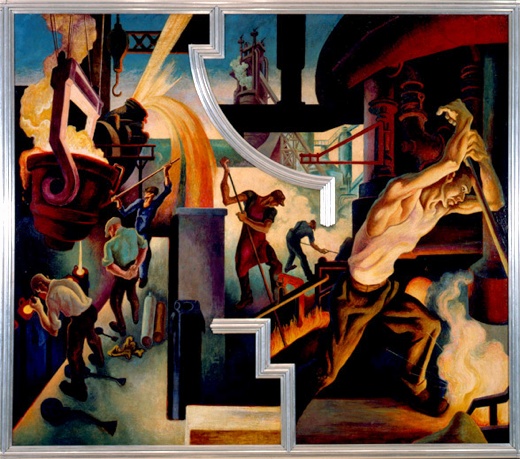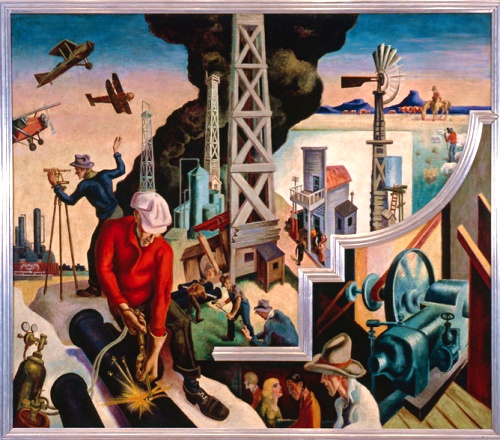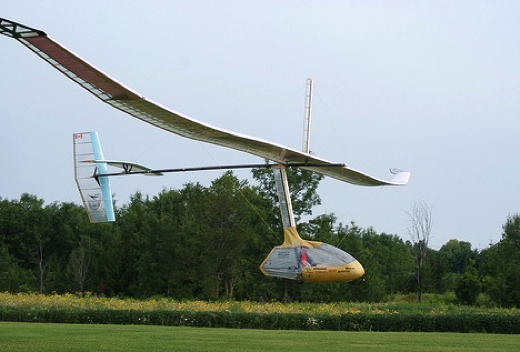SUBHEAD: We need a new American dream, one that doesn’t require promises of limitless material abundance.
By John Michael Greer on 13 March 2013 for Archdruid Report -
(
http://thearchdruidreport.blogspot.com/2013/03/reinventing-america.html)
 Image above: Detail of "America Today". "Coal" section in mural by Thomas Hart Benton, 1930. From (http://www.metmuseum.org/about-the-museum/now-at-the-met/from-the-director/2012/benton).
Image above: Detail of "America Today". "Coal" section in mural by Thomas Hart Benton, 1930. From (http://www.metmuseum.org/about-the-museum/now-at-the-met/from-the-director/2012/benton).
It’s been more than a year now since my posts here on The Archdruid Report veered away from the broader theme of this blog, the decline of industrial civilization, to consider the rise and impending fall of America’s global empire. That was a necessary detour, and the points I’ve tried to explore since last February will have no small impact on the outcome of the broader trajectory of our age.
It’s only in the imaginary worlds erected by madmen and politicians, after all, that the world is limited to one crisis at a time. In the real world, by contrast, multiple crises piling atop one another are the rule rather than the exception, and tolerably often it’s the pressure of immediate troubles that puts a solution to the major crises of an age out of reach.
Here in America, at least, that’s the situation we face today. The end of the industrial age, and the long descent toward the ecotechnic societies of the far future, defines the gravest of the predicaments of our time, but any action the United States might pursue to deal with that huge issue also has to cope with the less gargantuan but more immediate impacts of the end of America’s age of empire.
This latter issue has a great deal to say about what responses to the former predicament are and aren’t possible for us. Among the minority of Americans who have woken up to the imminent twilight of the age of cheap energy, for example, far and away the most popular response is to hope that some grand technological project or other can be deployed in time to replace fossil fuels and keep what James Howard Kunstler calls “the paradise of happy motoring” rolling on into the foreseeable future. It’s an understandable hope, drawing on folk memories of the Manhattan Project and the Apollo program.
There are solid thermodynamic reasons why no such project could replace fossil fuels, but let’s set that aside for the moment, because there’s a more immediate issue here: can a post-imperial America still afford any project on that scale?
History is a far more useful guide here than the wishful thinking and cheerleader’s rhetoric so often used to measure such possibilities. What history shows, to sum up thousands of years of examples in a few words, is that empires accomplish their biggest projects early on, when the flow of wealth in from the periphery to the imperial center—the output of those complex processes I’ve termed the imperial wealth pump—is at its height, before the periphery is stripped of its movable wealth and the center has slipped too far into the inflation that besets every imperial system sooner or later.
The longer an empire lasts and the more lavish the burden it imposes on its periphery, the harder it is to free up large sums of money (or the equivalent in nonfinancial resources) for grand projects, until finally the government has to scramble to afford even the most urgent expenditures.
We’re well along that curve in today’s America. The ongoing disintegration of our built infrastructure is only one of the many problem lights flashing bright red, warning that the wealth pump is breaking down and the profits of empire are no longer propping up a disintegrating domestic economy. Most Americans, for that matter, have seen their effective standard of living decline steadily for decades.
Fifty years ago, for example, many American families supported by one full time working class income owned their own homes and lived relatively comfortable lives. Nowadays? In many parts of the country, one full time working class income won’t even keep a family off the street.
The US government’s ongoing response to the breakdown of the imperial wealth pump has drawn a bumper crop of criticism, much of it well founded. Under most circumstances, after all, an economic policy that focuses on the mass production of imaginary wealth via the deliberate encouragement of speculative excess is not a good idea.
Still, it’s only fair to point out that there really isn’t much else any US administration could do—not and survive the next election, at least. In the abstract, most Americans believe in fiscal prudence, but when any move toward fiscal prudence risks setting off an era of economic contraction that would put an end to the extravagant lifestyles most Americans see as normal, abstract considerations quickly give way.
Thus it’s a safe bet that the federal government will keep following its present course, pumping the economy full of imaginary wealth by way of the Fed’s printing presses, artificially low rates of interest, and a dizzying array of similar gimmicks, in order to maintain the illusion of abundance a little longer, and keep the pressure groups that crowd around the government feeding trough from becoming too unruly. In the long run, it’s a fool’s game, but nobody in Washington DC can afford to think in the long run, not when their political survival depends on what happens right now.
That’s the stumbling block in the way of the grand projects that still take up so much space in the peak oil blogosphere: the solar satellites, the massive buildout of thorium reactors, the projects to turn some substantial portion of Nevada into algal biodiesel farms, or what have you.
Any such project that was commercially viable would already be under construction—with crude oil hovering around $100 a barrel on world markets, remember, there’s plenty of incentive for entrepreneurs to invest in new energy technologies.
Lacking commercial viability, in turn, such a project would have to find ample funding from the federal government, and any such proposal runs into the hard fact that every dollar that rolls off the Fed’s printing presses has a pack of hungry pressure groups baying for it already.
It’s easy to insist that solar satellites are more important than, say, jet fighters, the Department of Education, or some other federal program, and in a good many cases, this insistence is probably true. On the other hand, jet fighters, the Department of Education, and other existing federal programs have large and politically savvy constituencies backing them, which are funded by people whose livelihoods depend on those programs, and which have plenty of experience putting pressure on Congress and the presidency if their pet programs are threatened.
It’s easy to insist, in turn, that politicians ought to ignore such pressures, but those who want to survive the next election don’t have that luxury—and if they did make it a habit to ignore pressure from their constituents, where would that leave the people who want to lobby for solar satellites, thorium reactors, or the like?
 Image above: Detail of "America Today". "Steel" section in mural by Thomas Hart Benton, 1930. From (http://www.decorartsnow.com/2012/12/13/thomas-hart-bentons-america-today/).
Image above: Detail of "America Today". "Steel" section in mural by Thomas Hart Benton, 1930. From (http://www.decorartsnow.com/2012/12/13/thomas-hart-bentons-america-today/).
Meanwhile the broader economic basis that could make a buildout of alternative energy technologies possible has mostly finished trickling away. The United States is a prosperous country on paper, because the imaginary wealth manufactured by government and the financial industry alike still finds buyers who are willing to gamble that business as usual will continue for a while longer.
Mind you, the government’s paper wealth is finding a dwindling supply of takers these days, Most treasury bills are currently being bought by the Fed, and while any number of reasons have been cited for this policy, I’ve come to suspect that most of what’s behind it is the simple fact that most other potential buyers aren’t interested.
If the law of supply and demand were to come into play, interest rates on treasury bills would have to rise as the pool of buyers shrank. That’s not something any US government can afford—the double whammy of a major recession and a sharp rise in the cost of financing the national debt would almost certainly trigger the massive economic and political crisis both parties are desperately trying to avoid.
Instead, the torrent of paper liquidity allows the same thing to happen more slowly and less visibly, as creditor nations take their shares of that torrent and use it to outbid the United States in the increasingly unruly global scramble for what’s left of the planet’s fossil fuels and other nonrenewable resources.
A great many people are wondering these days when the resulting bubble in US paper wealth—for that’s what it is, of course—is going to pop. That might still happen, especially as a side effect of a sufficiently sharp political or military crisis, but it’s also possible that the trillions of dollars in imaginary wealth that currently prop up America’s domestic economy could trickle away more gradually, by way of stagflation or any of the other common forms of prolonged economic dysfunction.
We could, in other words, get the kind of massive crisis that throws millions of people out of work and erases the value of trillions of dollars of paper wealth in a matter of months; we could equally well get the more lengthy and less visible kind of crisis, in which every year that passes sees an ever larger fraction of the population driven out of the work force, an ever larger fraction of the nation’s wealth reduced to paper that would be worth plenty if only anybody were willing and able to buy it, and an ever larger part of the nation itself turning visibly into one more impoverished and misgoverned Third World nation.
Either way, the economic unraveling is bound to end in political crisis. Take a culture that assumes an endlessly rising curve of prosperity, and put it in a historical setting that puts that curve forever out of reach, and sooner or later an explosion is going to happen. A glance back at the history of Communism makes a good reminder of what happens in the political sphere when rhetoric and reality drift too far apart, and the expectations cultivated by a political system are contradicted daily by the realities its citizens have to face.
As the American dream sinks into an American nightmare of metastatic poverty, disintegrating infrastructure, and spreading hopelessness, presided over by a baroque and dysfunctional bureaucratic state that prattles about freedom while loudly insisting on its alleged constitutional right to commit war crimes against its own citizens, scenes like the ones witnessed in a dozen eastern European capitals in the late 20th century are by no means unthinkable here.
Whether or not the final crisis takes that particular form or some other, it’s a safe bet that it will mark the end of what, for the last sixty years or so, has counted as business as usual here in the United States.
As discussed in an earlier post in this series, this has happened many times before. It’s as old as democracy itself, having been chronicled and given a name, anacyclosis, in ancient Greece. Three previous versions of the United States—call them Colonial America, Federal America, and Gilded Age America—each followed the same trajectory toward a crisis all too familiar from today’s perspective.
Too much political power diffusing into the hands of pressure groups with incompatible agendas, resulting in gridlock, political failure, and a collapse of legitimacy that in two cases out of three had to be reestablished the hard way, on the battlefield: we’re most of the way there this time around, too, as Imperial America follows its predecessors toward the recycle bin of history.
Our fourth trip around the track of anacyclosis may turn out to be considerably more challenging than the first three, though, partly for reasons already explored in this sequence of posts, and partly due to another factor entirely. The reasons discussed before are the twilight of America’s global empire and the end of the age of cheap abundant energy, both of which guarantee that whatever comes out of this round of anacyclosis will have to get by on much less real wealth than either of its two most recent predecessors. The reason I haven’t yet covered is a subtler thing, but in some ways even more potent.
The crises that ended Colonial America, Federal America, and Gilded Age America all happened in part because a particular vision of what America was, or could be, was fatally out of step with the times, and had to be replaced. In two of the three cases, there was another vision already in waiting: in 1776, a vision of an independent republic embodying the ideals of the Enlightenment; in 1933, a vision of a powerful central government using its abundant resources to dominate the world while, back at home, embodying the promises of social democracy. (Not, please note, socialism; socialism is state ownership of the means of production, social democracy is the extension of democratic ideals into the social sphere by means of government social welfare programs. The two are not the same, and it’s one of the more embarrassing intellectual lapses of today’s American pseudoconservatism that it so often tries to pretend otherwise.)
In the third, in 1860, there were not one but two competing visions in waiting: one that drew most of its support from the states north of the Mason-Dixon line, and one that drew most of its support from those south of it. What made the conflicts leading up to Fort Sumter so intractable was precisely that the question wasn’t simply a matter of replacing a failed ideal with one that might work, but deciding which of two new ideals would take its place.
Would the United States become an aristocratic, agrarian society fully integrated with the 19th century’s global economy and culture, like the nations further south between the Rio Grande and Tierra del Fuego, or would it go its own way, isolating itself economically from Europe to protect its emerging industrial sector and decisively rejecting the trappings of European aristocratic culture? The competing appeal of the two visions was such that it took four years of war to determine that one of them would triumph across a united nation.
 Image above: Image above: Detail of "America Today". "Oil" section in mural by Thomas Hart Benton, 1930. From (http://nbmaa.wordpress.com/2012/12/18/a-tale-of-two-murals/m1/).
Image above: Image above: Detail of "America Today". "Oil" section in mural by Thomas Hart Benton, 1930. From (http://nbmaa.wordpress.com/2012/12/18/a-tale-of-two-murals/m1/).
Our situation in the twilight years of Imperial America is different still, because a vision that might replace the imperial foreign policy and domestic social social democracy of 1933 has yet to take shape.
The image of America welded into place by Franklin Roosevelt during the traumatic years of the Great Depression and the Second World War still guides both major parties—the Republicans, for all their eagerness to criticize Roosevelt’s legacy, have proven themselves as quick to use federal funds to pursue social agendas as any Democrat, while the Democrats, for all their lip service to the ideals of world peace and national self-determination, have proven themselves as eager to throw America’s military might around the globe as any Republican.
Both sides of the vision of Imperial America depended utterly on access to the extravagant wealth that America could get in 1933, partly from its already substantial economic empire in Latin America, partly from the even more substantial "empire of time" defined by Appalachia’s coal mines and the oilfields of Pennsylvania and Texas.
Both those empires are going away now, and everything that depends on them is going away with equal inevitability—and yet next to nobody in American public life has begun to grapple with the realities of a post-imperial and post-industrial America, in which debates over the fair distribution of wealth and the extension of national power overseas will have to give way to debates over the fair distribution of poverty and the retreat of national power to the borders of the United States and to those few responsibilities the constitution assigns to the federal government.
We don’t yet have the vision that could guide that process. I sometimes think that such a vision began to emerge, however awkwardly and incompletely, in the aftermath of the social convulsions of the 1960s.
During the decade of the 1970s, between the impact of the energy crisis, the blatant failure of the previous decade’s imperial agendas in Vietnam and elsewhere, and the act of collective memory that surrounded the nation’s bicentennial, it became possible for a while to talk publicly about the values of simplicity and self-sufficiency, the strengths of local tradition and memory, and the worthwhile things that were lost in the course of America’s headlong rush to empire.
I’ve talked elsewhere about the way that this nascent vision helped guide the first promising steps toward technologies and lifestyles that could have bridged the gap between the age of cheap abundant energy and a sustainable future of relative comfort and prosperity.
Still, as we know, that’s not what happened; the hopes of those years were stomped to a bloody pulp by the Reagan counterrevolution, Imperial America returned with a vengeance, and stealing from the future became the centerpiece of a bipartisan consensus that remains welded into place today.
Thus one of the central tasks before Americans today, as our nation’s imperial age stumbles blindly toward its end, is that of reinventing America: that is, of finding new ideals that can provide a sense of collective purpose and meaning in an age of deindustrialization and of economic and technological decline.
We need, if you will, a new American dream, one that doesn’t require promises of limitless material abundance, one that doesn’t depend on the profits of empire or the temporary rush of affluence we got by stripping a continent of its irreplaceable natural resources in a few short centuries.
I think it can be done, if only because it’s been done three times already. For that matter, the United States is far from the only nation that’s had to find a new meaning for itself in the midst of crisis, and a fair number of other nations have had to do it, as we will, in the face of decline and the failure of some extravagant dream.
Nor will the United States be the only nation facing such a challenge in the years immediately ahead: between the tectonic shifts in geopolitics that will inevitably follow the fall of America’s empire, and the far greater transformations already being set in motion by the imminent end of the industrial age, many of the world’s nations will have to deal with a similar work of revisioning.
That said, nothing guarantees that America will find the new vision it needs, just because it happens to need one, and it’s very late in the day. Those of us who see the potential, and hope to help fill it, will have to get a move on.
.










